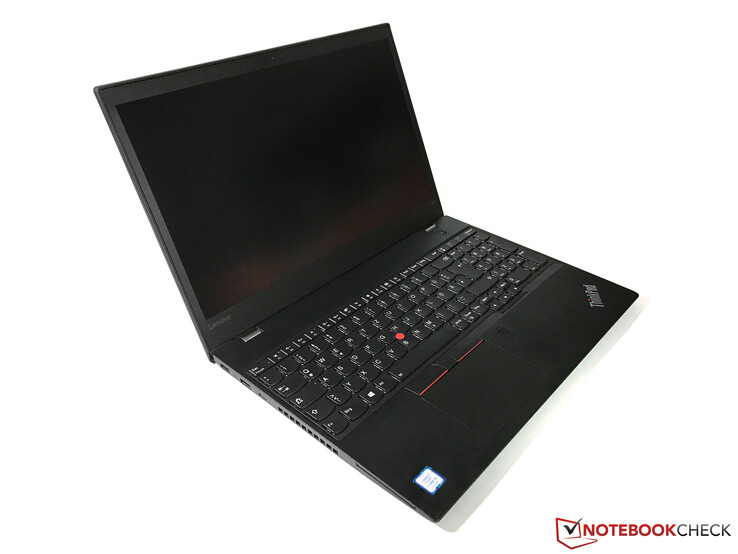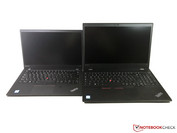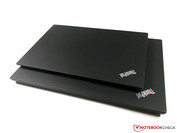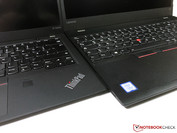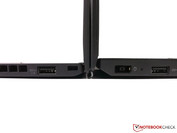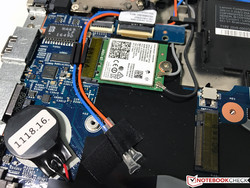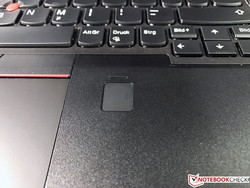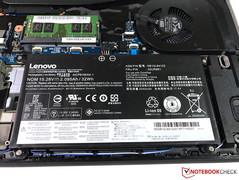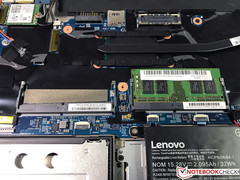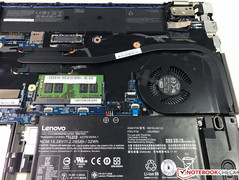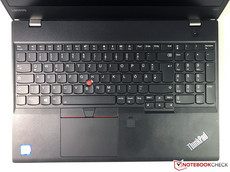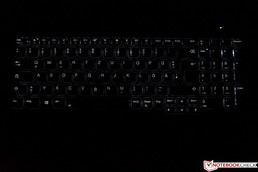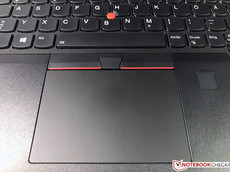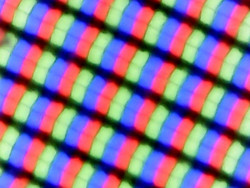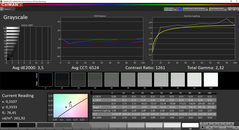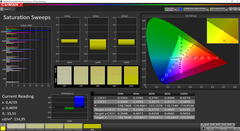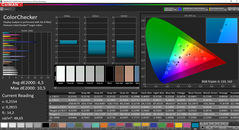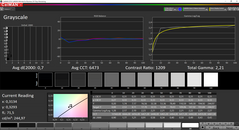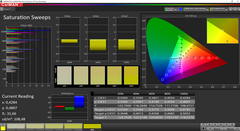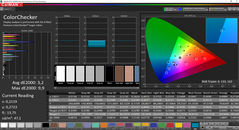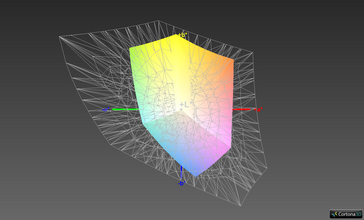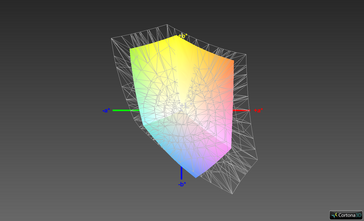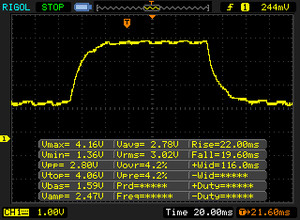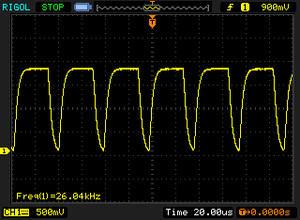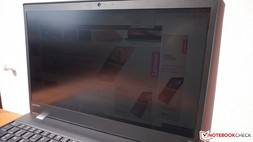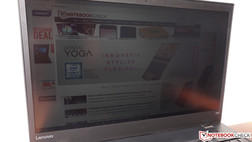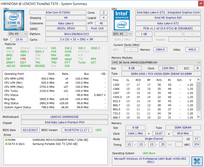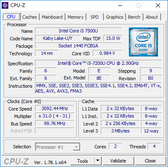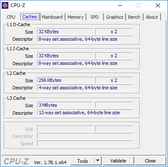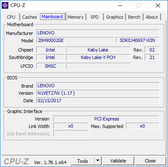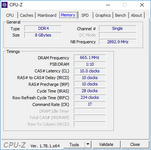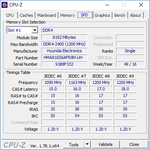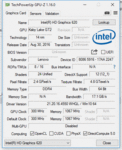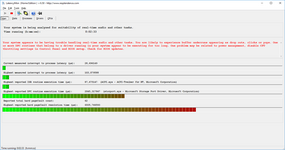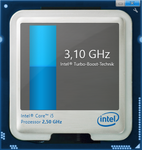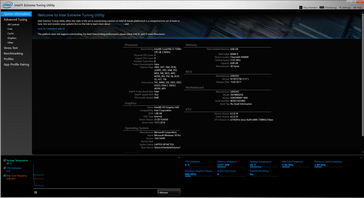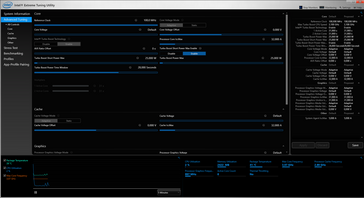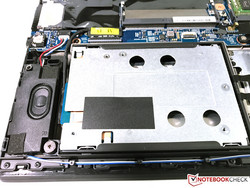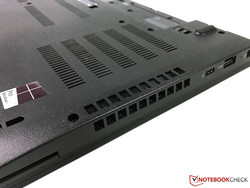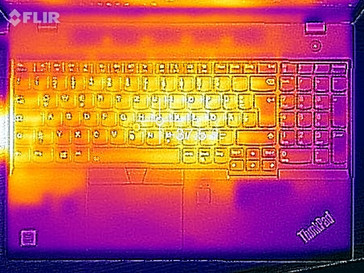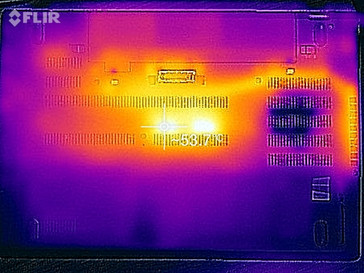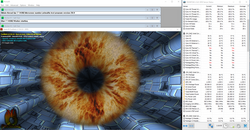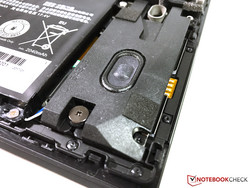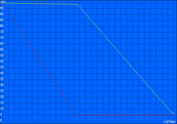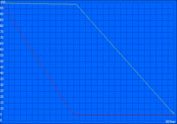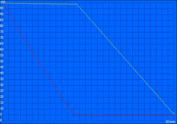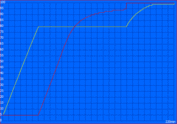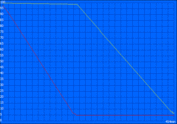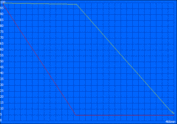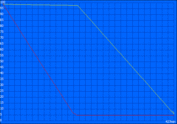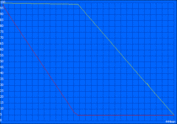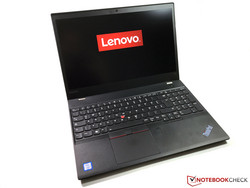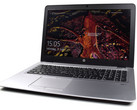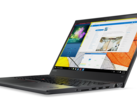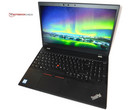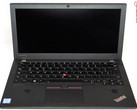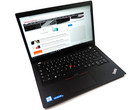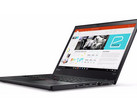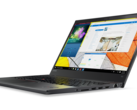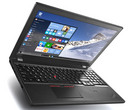Lenovo ThinkPad T570 (Core i5, Full HD) Laptop Review

For the original German review, see here.
Lenovo's Kaby Lake update of the ThinkPad T5x0 uses a completely revised chassis, similar to the smaller sibling, the ThinkPad T470. You can mainly notice this thanks to the smaller display bezels and the lack of space next to the keyboard. It is the first major redesign since the ThinkPad T550 two years ago.
Here we review the ThinkPad T570-20H90002GE, which is currently the least expensive top-seller version for 1549 Euros (~$1662). You will get a Kaby Lake Core i5 processor, 8 GB of DDR4 RAM, a 256 GB NVMe-SSD, and the Full HD panel. The corresponding Education version (for students, teacher, etc.) is available for just 1299 Euros (~$1394). The T570 can also be equipped with a high-resolution 4K panel as well as the dedicated GeForce 940MX GPU (GDDR5) this year. We will also review this SKU soon.
Competitors for the ThinkPad T570 are obviously other classic business notebooks such as the HP EliteBook 850 G4 or the Fujitsu LifeBook U757. Currently, Dell does not offer a direct rival, because the models from the Inspiron 7000-series stop at 14 inches. However, the line between consumer and business notebooks has been fading for the last few years, which is a result of versatile ports such as Thunderbolt 3, but also the increasing popularity of biometric access protections (such as Windows Hello, fingerprint scanner and the like). Traditional business notebooks also lose "classic" virtues such as replaceable batteries, modular drive bays or advantages in terms of maintenance. We will therefore also use the current Dell XPS 15 9560 and the Apple MacBook Pro 15 as comparison devices, which are definitely interesting alternatives for some users.
Case
As with the smaller sibling ThinkPad T470 (14 inches), Lenovo has equipped the ThinkPad T570 with a new case. The most noticeable change compared to the previous ThinkPad T560 is probably the color. The old system used dark-gray surfaces, while Lenovo now goes back to the classic black. Otherwise, however, the design is very familiar, and it is a matter of taste: Some users think the boxy shape is classic, while others think it is boring. The ThinkPad T570 definitely leaves a good impression in productive environments.
The whole construction is made from glass-fiber reinforced plastic. The tactile feel is identical to that of the smaller ThinkPad T470, and the surface feels much rougher compared to the velvety-soft surfaces of the more expensive ThinkPad T470s, for example. The new case of the 15-inch laptop is very compact and very well-built. Neither pressure nor twisting attempts are a big challenge for the base, only the central keyboard area will flex a bit under a lot of force. Lenovo says the system was also tested according to military specifications (MIL-STD-810G), but there are no specifics about the individual tests.
Two metal hinges connect the base to the display. They allow a maximum opening angle of 180 degrees. They are very firm and keep the display well in position, because the display only bounces slightly when there are vibrations. You can open the lid with one hand, but it requires some fiddling and it is easier with both hands. The lid itself cannot quite keep up with the stability of the base. The lower display bezel between the hinges in particular can easily be warped, which also results in local backlight bleeding. Otherwise, however, there are no problems, and we cannot provoke picture distortions with pressure from behind.
Lenovo does not include maintenance hatches, so you have to remove the entire bottom cover before you can access the components (more on that later). At least, you can remove one of the two batteries from the outside. It does not have a support foot, so you can use the system without the battery and the system will not wobble.
Overall, we can repeat what we have already said for the smaller ThinkPad T470: Both the case stability and quality are very good, but unibody constructions still have the edge in this respect.
We still had the test sample of the new X1 Carbon 2017 here and took the chance to compare these two rather different competitors. The display of the X1 Carbon 2017 is only one digit smaller (14 vs. 15.6 inches), but the footprint comparison in particular shows a significant difference, and the ThinkPad T570 obviously does not stand a chance.
The comparison with the immediate business rivals leaves a much better impression for the new T570. Lenovo was able to reduce the width by ~1.5 cm (~0.6 in) compared to the predecessor. The weight is also 300 grams (~11 oz) lighter, but the new construction is slightly deeper in return. It is therefore the most compact model except for the two consumer laptops Dell XPS 15 and Apple MacBook Pro 15. They are a better choice when you travel a lot and need the most compact 15-inch system.
Connectivity – Thunderbolt 3
The port variety is both comprehensive as well as modern. Besides three regular USB 3.0 ports (Type-A), which manage an average transfer rate of around 380 MB/s (Samsung SSD T3), Lenovo has also implemented a versatile USB-C port (Gen2). It supports Power Delivery, Thunderbolt 3 as well as the video output via DisplayPort 1.2a, so you can also drive a 4K panel at 60 Hz. You can also the full-size HDMI port (1.4b), but it can only drive a 4K panel at 24 Hz. Overall, the ThinkPad T570 supports three independent displays (including the internal).
The USB-C port can also be used for power adapters or docking stations, so the position is obviously important. Lenovo has recently screwed up a bit with the ThinkPad T470s, but there are no problems with the T570. It is located at the left rear, so there should not be any restrictions in operation.
SD Card Reader
The full-size SD card reader is located at the right front (UHS-I) and takes the memory card completely (sprung-loaded). We determine average results with our reference card from Toshiba (Exceria Pro SDXC 64 GB UHS-II, up to 260 MB/s): up to 90 MB/s, and around 74 MB/s when we copy pictures. This means that all the business rivals are roughly on par, but the Dell XPS 15 is much faster at more than 200 MB/s (the low performance in the copy test is related to the mechanical hard drive).
| SD Card Reader | |
| average JPG Copy Test (av. of 3 runs) | |
| Fujitsu LifeBook U757 | |
| Lenovo ThinkPad T570-20H90002GE | |
| HP EliteBook 850 G4-Z2W86ET | |
| Dell XPS 15 2017 9560 (7300HQ, Full-HD) | |
| maximum AS SSD Seq Read Test (1GB) | |
| Dell XPS 15 2017 9560 (7300HQ, Full-HD) | |
| Lenovo ThinkPad T570-20H90002GE | |
| HP EliteBook 850 G4-Z2W86ET | |
| Fujitsu LifeBook U757 | |
Communication – LTE optional
Lenovo has equipped the ThinkPad T570 with a Gigabit Ethernet port for wired network connections and obviously a Wi-Fi module. The specification sheet lists different adapters from Realtek and Intel that support at least 802.11ac. In addition, there is an ad-module, which is also required for the optional WiGig Docking Station (here in review).
Our test model uses the Intel 8265 (2x2 adapter), which has an advertised maximum transfer rate of 867 Mbps. Our standardized Wi-Fi test with the router Linksys EA8500 (at a distance of 1 meter/3 ft) determines the good results that we already know from this module: ~640 Mbps receive as well as ~560 Mbps send. We did not have any problems with the Wi-Fi connection during our review period. The Intel 8265 also supports Bluetooth 4.2, but according to Lenovo, it is limited to Bluetooth 4.1 by the OS.
Inside the case is a free M.2 slot (2242) for an optional WWAN module. The required antennas (see picture) are already prepared, so it is easy to upgrade it at a later time. The corresponding slot for the Micro-SIM is located in the battery tray. WWAN and WiGig can coexist on the ThinkPad T570.
Lenovo also ships some SKUs of the ThinkPad T570 with IR cameras for Windows Hello, but our test model is equipped with the usual 720p HD webcam. Nothing has changed compared to the previous model; the webcam does its job in video conferences, but the overall quality is bad. The dual-array microphone on the other hand works well.
Security
The security features are very comprehensive. You can protect the access to the T570 via fingerprint scanner (Touch) or SmartCard. Unlike the old ThinkPad T560, it is now a very comfortable touch sensor, where you just have to put your finger on. We have already mentioned that there is an optional infrared camera for Windows Hello. You can obviously set up different passwords for the OS and BIOS. A Trusted Platform Module is available as well, and a slot for a Kensington Lock keeps the laptop on the desk.
Accessories
Our configuration of the ThinkPad T570 comes with a 45-watt power adapter (Slim-Tip), while SKUs with the dedicated graphic card get a 65-watt module. Otherwise, the box contains only a quick-start guide and some warranty information.
However, Lenovo offers a number of optional accessories, including several docking stations. You will find classic models for the docking port at the bottom of the T570, but also modern USB-C/TB 3 stations. The prices range between 120 Euros (~$129) for simple USB docking stations all the way up to 300 Euros (~$322) for the WiGig model. Docking stations from previous generations (from T540p) are still compatible.
Maintenance
Access to the components requires the removal of the entire lower case cover. However, this is easier said than done, because there are Philips screws as well as plastic clips. They can easily break, so you should be very careful when you remove the cover.
Inside the case are two regular DDR4 memory slots. One of them is still free on our test model, so an upgrade is no problem (up to 32 GB). The M.2 SSD is attached to the 2.5-inch tray via an adapter. Lenovo says the M.2-2242 slot, which is originally designed for a WWAN module, can also be equipped for an additional SSD (SATA-III). The internal battery is secured by screws only and could easily be replaced if necessary.
Warranty
A warranty period of three years is usual in this segment, and the ThinkPad T570 is no exception with a 36-month on-site service. Lenovo also offers other options, including longer life extensions all the way up to five years (145 Euros/~156) or additional services such as "keep your drive" (5 years, 199 Euros/~$214). Please see our Guarantees, Return policies and Warranties FAQ for country-specific information.
Input Devices
Keyboard – Precision Keyboard
Lenovo is still using a black chiclet keyboard with the designation Precision Keyboard, which comes with a dedicated numeric keypad. At a first glance, it seems to be identical to that of the ThinkPad T560, but the size has taken a small hit due to the smaller case. The manufacturer had to narrow some keys to fit into the narrower chassis. This includes the three keys right next to the space bar as well as the four keys left next to return. You will have to get used to that a bit, but the rich feedback can easily make up for this. The mechanics still benefit from a comparatively long key travel as well as a firm pressure point. The slightly concave keys are great for prolific writers. A two-stage white illumination improves the typing experience in dark environments.
Touchpad and TrackPoint
There are also some changes to the mouse replacement. The touchpad surface now starts directly at the dedicated buttons for the TrackPoint – the previous T560 still had a small plastic strip. It is also a so called Precision Touchpad, where the inputs are executed by Windows instead of a third-party driver. This also means that you will find all the important settings in the Windows settings. The Synaptics driver panel, which used to be very comprehensive, offers only a few features. The smooth touchpad works very well in practice and does not clatter. The size is sufficient at 10 x 7 cm (~4 x 2.7 in) – a larger touchpad is prevented by the three dedicated TrackPoint buttons.
The small red joystick in the middle of the keyboard is obviously available as well. It has three dedicated mouse buttons, and the cursor movement is very easy and comfortable – although this is obviously a matter of taste. The three buttons are well-implemented and produce a very even clicking sound on our test model.
Display – Full HD IPS
Lenovo offers three display options for the new ThinkPad T570. However, the "small" HD panel (1366x768 pixels) is not available in Germany so you will have to choose between the Full HD screen and the new high-resolution 4K screen. Both feature a matte surface and are based on the IPS technology. We will cover the 4K screen in a separate review, because our test model is equipped with the Full HD display. 1920x1080 pixels result in a pixel density of 141 PPI on the 15.6-inch screen. 4K panels obviously have an advantage in this respect, but we think Full HD is still a decent choice, especially since there are no scaling options.
Lenovo advertises low luminance and contrast values of the screen (N156HCA-EAA), and we can unfortunately confirm this for the background illumination. The advertised value of 250 nits is surpassed at up to 262 nits, but the average value drops to 245 nits. This means that the T570 beats the old ThinkPad T560, but the two laptops from Dell as well as Apple in particular show what is possible in this respect.
The comparatively low luminance does have some advantages, though, such as the black value. It is very low for an IPS panel at just 0.24, which results in a very good contrast ratio of more than 1000:1. There is no annoying backlight bleeding either, so the subjective picture impression is good.
| |||||||||||||||||||||||||
Brightness Distribution: 89 %
Center on Battery: 257 cd/m²
Contrast: 1092:1 (Black: 0.24 cd/m²)
ΔE ColorChecker Calman: 4.5 | ∀{0.5-29.43 Ø4.78}
ΔE Greyscale Calman: 3.5 | ∀{0.09-98 Ø5}
65.4% sRGB (Argyll 1.6.3 3D)
42.04% AdobeRGB 1998 (Argyll 1.6.3 3D)
45.66% AdobeRGB 1998 (Argyll 3D)
65.6% sRGB (Argyll 3D)
44.08% Display P3 (Argyll 3D)
Gamma: 2.32
CCT: 6524 K
| Lenovo ThinkPad T570-20H90002GE N156HCA-EAA, , 1920x1080, 15.6" | Apple MacBook Pro 15 2016 (2.6 GHz, 450) 2880x1800, 15.4" | Fujitsu LifeBook U757 LP156WF6-SPP1, , 1920x1080, 15.6" | HP EliteBook 850 G4-Z2W86ET AUO35ED, , 1920x1080, 15.6" | Dell XPS 15 2017 9560 (7300HQ, Full-HD) Sharp SHP1453 LQ156M1, , 1920x1080, 15.6" | Lenovo ThinkPad T560-20FH001FGE LTN156HL09901, , 1920x1080, 15.6" | |
|---|---|---|---|---|---|---|
| Display | 38% | 29% | 54% | -7% | ||
| Display P3 Coverage (%) | 44.08 | 65.8 49% | 56.8 29% | 68.9 56% | 40.96 -7% | |
| sRGB Coverage (%) | 65.6 | 84.8 29% | 83.7 28% | 98.9 51% | 61.3 -7% | |
| AdobeRGB 1998 Coverage (%) | 45.66 | 62 36% | 58.7 29% | 70.9 55% | 42.36 -7% | |
| Response Times | -32% | -7% | 7% | -91% | -56% | |
| Response Time Grey 50% / Grey 80% * (ms) | 41.6 ? | 47.3 ? -14% | 36 ? 13% | 47.2 ? -13% | 54 ? -30% | 58 ? -39% |
| Response Time Black / White * (ms) | 20.8 ? | 31.2 ? -50% | 26.4 ? -27% | 15.2 ? 27% | 52.4 ? -152% | 36 ? -73% |
| PWM Frequency (Hz) | 26040 ? | 117000 ? | 199.2 ? | 220 ? | ||
| Screen | 46% | 7% | -68% | 13% | -29% | |
| Brightness middle (cd/m²) | 262 | 483 84% | 313 19% | 338 29% | 400 53% | 243 -7% |
| Brightness (cd/m²) | 245 | 465 90% | 294 20% | 341 39% | 392 60% | 220 -10% |
| Brightness Distribution (%) | 89 | 92 3% | 84 -6% | 90 1% | 89 0% | 84 -6% |
| Black Level * (cd/m²) | 0.24 | 0.33 -38% | 0.27 -13% | 0.81 -238% | 0.26 -8% | 0.27 -13% |
| Contrast (:1) | 1092 | 1464 34% | 1159 6% | 417 -62% | 1538 41% | 900 -18% |
| Colorchecker dE 2000 * | 4.5 | 1.4 69% | 4.5 -0% | 10.9 -142% | 4.9 -9% | 7.49 -66% |
| Colorchecker dE 2000 max. * | 10.5 | 3 71% | 10.5 -0% | 18.7 -78% | 11 -5% | 15.13 -44% |
| Greyscale dE 2000 * | 3.5 | 1.5 57% | 4 -14% | 13.3 -280% | 7.2 -106% | 7.5 -114% |
| Gamma | 2.32 95% | 2.34 94% | 2.24 98% | 2.11 104% | 2.11 104% | 2.35 94% |
| CCT | 6524 100% | 6650 98% | 6387 102% | 16030 41% | 6911 94% | 6115 106% |
| Color Space (Percent of AdobeRGB 1998) (%) | 42.04 | 55.3 32% | 53.8 28% | 64.2 53% | 38.9 -7% | |
| Color Space (Percent of sRGB) (%) | 65.4 | 84.74 30% | 83.4 28% | 98.9 51% | 60.9 -7% | |
| Total Average (Program / Settings) | 7% /
31% | 13% /
12% | -11% /
-38% | -8% /
7% | -31% /
-28% |
* ... smaller is better
The Full HD panel of the T570 already manages decent average DeltaE-2000 deviations compared to the sRGB reference ex-works. We determine average results of 3.5 (grayscale) and 4.5 (colors), respectively, with the professional software CalMAN and a spectrophotometer. This is not far removed from the target area (smaller 3), but the colors in particular show big outliers at more than 10 (blue). The calibrations (ICC profile linked in the box above) mainly improve the grayscale performance, where the average deviation drops to just 0.9. The colors improve a bit as well, but we can still see some outliers.
Display Response Times
| ↔ Response Time Black to White | ||
|---|---|---|
| 20.8 ms ... rise ↗ and fall ↘ combined | ↗ 6.8 ms rise | |
| ↘ 14 ms fall | ||
| The screen shows good response rates in our tests, but may be too slow for competitive gamers. In comparison, all tested devices range from 0.1 (minimum) to 240 (maximum) ms. » 45 % of all devices are better. This means that the measured response time is similar to the average of all tested devices (20.2 ms). | ||
| ↔ Response Time 50% Grey to 80% Grey | ||
| 41.6 ms ... rise ↗ and fall ↘ combined | ↗ 22 ms rise | |
| ↘ 19.6 ms fall | ||
| The screen shows slow response rates in our tests and will be unsatisfactory for gamers. In comparison, all tested devices range from 0.165 (minimum) to 636 (maximum) ms. » 66 % of all devices are better. This means that the measured response time is worse than the average of all tested devices (31.6 ms). | ||
Screen Flickering / PWM (Pulse-Width Modulation)
| Screen flickering / PWM detected | 26040 Hz | ≤ 40 % brightness setting | |
The display backlight flickers at 26040 Hz (worst case, e.g., utilizing PWM) Flickering detected at a brightness setting of 40 % and below. There should be no flickering or PWM above this brightness setting. The frequency of 26040 Hz is quite high, so most users sensitive to PWM should not notice any flickering. In comparison: 53 % of all tested devices do not use PWM to dim the display. If PWM was detected, an average of 8108 (minimum: 5 - maximum: 343500) Hz was measured. | |||
The luminance does not drop on battery power, but you still have problems in bright environments. 250 nits is not sufficient for a comfortable experience, despite the matte panel surface. However, there are no limitations in the shade.
The IPS display provides wide viewing angles in general, but we have already reviewed better models. You can quickly notice a brightness drop at an angle from above or below, but at least there are no problems with inverting colors.
Performance
Lenovo offers several versions of the ThinkPad T570. You can choose between pre-configured models or customize it in Lenovo's online shop. The manufacturer only offers efficient dual-core ULV processors, despite the size. You will have to switch to the ThinkPad T470s (review soon) or the workstation models ThinkPad P51 or P71, respectively, if you need the performance of a quad-core CPU. More graphics performance is provided by the dedicated Nvidia GeForce 940MX (GDDR5), but the graphics of our test model is only handled by the integrated processor GPU. Overall, you can customize the ThinkPad T570 to a certain degree.
Processor – Intel Core i5-7200U
The Intel Core i5-7200U is a modern dual-core processor from Intel’s efficient ULV-series with a typical power consumption of up to 15 watts. It is not a performance wizard, but the Kaby Lake processor is still a good choice for many office tasks, thanks to a maximum Turbo Boost of up to 3.1 GHz (also for two active cores). Hyperthreading is supported as well, so the two native cores can execute up to four threads simultaneously.
More technical information about the 14 nm chip is available on our dedicated CPU page.
We encountered some performance bugs, though, which will accompany us through the next sections. The processor can utilize its maximum performance potential, at least in theory. This is supported by the good Cinebench R15 Multi score (330 points). Lenovo has increased the TDP limit to 25 watts, but we can still see the usual 15-watt limit occasionally. This is also the case for our Cinebench R15 Multi loop. The score levels off at around 320 points, and the initial result is also a bit lower since we can already see a slight drop of the CPU clock during the first benchmark run. We did not find the reason for this behavior. The limit was there in some cases, but not all the time (BIOS was up to date).
The ThinkPad T570 is still on par with the business competition in the benchmarks, while the two quad-core chips in the Apple and Dell obviously have a big advantage when we stress multiple cores. More benchmarks with the Intel Core i5-7200U are listed here.
Another problem, which is already familiar from the ThinkPad T470s, is the significantly reduced performance on battery power. It did not help to adjust the corresponding BIOS option either. However, the processor even drops below its nominal clock of 2.5 GHz, because the Cinebench Multi test is only executed at 2.2 to 2.4 GHz. This does not change even when we only stress one core. A CB R15 Multi run on battery power determines only 233 points, which is a drop of about ~30%.
System Performance
The system ran very smoothly during our review period and we did not notice any problems with the software or hardware. The system quickly boots thanks to the SSD and applications are also launched without delays. SKUs with conventional hard drives will feel more sluggish.
We use the synthetic benchmark PCMark 8 to check our impression. The results are very good, and the ThinkPad T570 is only beaten by the Dell XPS 15 in the important Work test. You can even slightly increase the performance by adding another memory module.
| PCMark 8 Home Score Accelerated v2 | 3523 points | |
| PCMark 8 Creative Score Accelerated v2 | 4380 points | |
| PCMark 8 Work Score Accelerated v2 | 4606 points | |
Help | ||
Storage Devices – Samsung PM961 NVMe-SSD
The storage situation is similar to the smaller ThinkPad T470. The primary slot has the 2.5-inch form factor and is attached via PCIe x2. You can either use corresponding 2.5-inch drives (up to 7 mm high) or NVMe modules via an adapter. The WWAN slot (M.2-2242) can also be used for a SATA-III SSD or Intel's new Optane storage.
Our test model is equipped with a 256 GB Samsung PM961. This PCIe-NVMe SSD is currently one of the fastest drives on the market, but is slightly slowed down by the PCIe x2 interface. Sequential transfer rates of around 1300 MB/s (read) and almost 1200 MB/s (write) are not bad by any means, but the results would be higher with the full PCIe x4 interface (compare ThinkPad T470s, for example). However, there are no limitations in the other categories, including the important 4K performance. You can use our comprehensive SSD/HDD list for more comparisons.
| Lenovo ThinkPad T570-20H90002GE Samsung PM961 MZVLW256HEHP | Apple MacBook Pro 15 2016 (2.6 GHz, 450) Apple SSD SM0256L | Fujitsu LifeBook U757 Samsung CM871a MZNTY256HDHP | HP EliteBook 850 G4-Z2W86ET Samsung PM951 NVMe MZVLV256 | Dell XPS 15 2017 9560 (7300HQ, Full-HD) WDC WD10SPCX-75KHST0 + SanDisk Z400s M.2 2242 32 GB Cache | Lenovo ThinkPad T470s-20HGS00V00 Samsung SSD PM961 1TB M.2 PCIe 3.0 x4 NVMe (MZVLW1T0) | |
|---|---|---|---|---|---|---|
| CrystalDiskMark 3.0 | -17% | -46% | -28% | -92% | 20% | |
| Read Seq (MB/s) | 1318 | 1298 -2% | 509 -61% | 1245 -6% | 123 -91% | 1760 34% |
| Write Seq (MB/s) | 1166 | 1343 15% | 488.4 -58% | 298.6 -74% | 74.2 -94% | 1666 43% |
| Read 512 (MB/s) | 933 | 842 -10% | 414.3 -56% | 673 -28% | 101.7 -89% | 832 -11% |
| Write 512 (MB/s) | 860 | 945 10% | 321.7 -63% | 298.8 -65% | 42.51 -95% | 1064 24% |
| Read 4k (MB/s) | 56.6 | 9.8 -83% | 36.43 -36% | 41.79 -26% | 10.84 -81% | 53.2 -6% |
| Write 4k (MB/s) | 130.6 | 13 -90% | 88.4 -32% | 138.4 6% | 1.021 -99% | 167.4 28% |
| Read 4k QD32 (MB/s) | 510 | 630 24% | 402.8 -21% | 495 -3% | 69.8 -86% | 630 24% |
| Write 4k QD32 (MB/s) | 426.4 | 443 4% | 256.7 -40% | 297.5 -30% | 1.057 -100% | 533 25% |
GPU Performance – Intel HD Graphics
There is not much left to say about the Intel HD Graphics 620. The graphics processor managed a maximum core clock of 1000 MHz in combination with the Core i5 processor. The GPU shares the memory with the rest of the system, so the performance would benefit from a dual-channel setup (+20 to 40%). The HD 620 is powerful enough for common office tasks, and even video editing is not a big problem as long as the software supports Intel's Quick Sync technology. For more details on the HD Graphics 620, see our dedicated GPU page.
There are no surprises in the synthetic benchmarks: The ThinkPad T570 performs well considering the single-channel memory, but the ThinkPad T470s (dual-channel) is between 24 and 43% faster depending on the test. However, the GPU clock is also a bit higher.
The Acer TravelMate P-259 is a good indicator for the performance of the optional Nvidia GeForce 940MX (GDDR5). It manages much higher scores (91 to 170% faster), but the two dedicated GPUs inside the Apple MacBook Pro as well as the Dell XPS 15 are still in a league of their own.
We can once again notice a significant performance drop on battery power. 3DMark 11 determines a GPU sub score of only 711 points (vs. 1431 on mains), so the performance drops by more than 50%. Once again, we suspect a software issue, since there is no good reason for this limitation.
| 3DMark 11 Performance | 1533 points | |
| 3DMark Ice Storm Standard Score | 51988 points | |
| 3DMark Cloud Gate Standard Score | 5741 points | |
| 3DMark Fire Strike Score | 774 points | |
Help | ||
Gaming Performance
The HD Graphics 620 is not a good choice for gaming, which is also supported by the benchmarks. Even older games like “Tomb Raider” or “BioShock Infinite” from 2013 are usually limited to low settings/resolutions. You could improve the performance a bit with a secondary memory module (~15 to 30% depending on the game), but we recommend the SKU with the dedicated GeForce 940MX if you plan on having some gaming sessions on your business laptop. Our gaming list shows what games run properly on the HD Graphics 620.
| low | med. | high | ultra | |
|---|---|---|---|---|
| Tomb Raider (2013) | 66.9 | 33.6 | 19.7 | 9.5 |
| BioShock Infinite (2013) | 41.7 | 24.4 | 20.2 | 6.6 |
| Battlefield 4 (2013) | 30.3 | 25.2 | 15.5 | 4.8 |
| The Witcher 3 (2015) | 13.1 | |||
| Rise of the Tomb Raider (2016) | 10.5 |
Emissions
System Noise
The cooling unit on our ThinkPad T570 consists of one fan and one heat pipe. The heat is dissipated at the left side. Configurations with the optional dedicated GPU will probably be equipped with a second heat pipe to handle the additional heat.
The fan is often deactivated while idling and only starts spinning from time to time, but it is still very quiet at 31.2 dB(A). You will start to hear the test model under load – our measurement device shows up to 38.7 dB(A). Other business rivals are better in this respect. At least, the noise is not inconvenient, and there are no other annoying sounds either.
Noise level
| Idle |
| 29.3 / 29.3 / 31.2 dB(A) |
| Load |
| 35.1 / 38.7 dB(A) |
 | ||
30 dB silent 40 dB(A) audible 50 dB(A) loud |
||
min: | ||
| Lenovo ThinkPad T570-20H90002GE i5-7200U, HD Graphics 620 | Apple MacBook Pro 15 2016 (2.6 GHz, 450) 6700HQ, Radeon Pro 450 | Fujitsu LifeBook U757 i5-7200U, HD Graphics 620 | HP EliteBook 850 G4-Z2W86ET i5-7200U, HD Graphics 620 | Dell XPS 15 2017 9560 (7300HQ, Full-HD) i5-7300HQ, GeForce GTX 1050 Mobile | Lenovo ThinkPad T560-20FH001FGE 6200U, HD Graphics 520 | |
|---|---|---|---|---|---|---|
| Noise | -5% | 7% | 6% | -14% | 2% | |
| off / environment * (dB) | 29.3 | 30.4 -4% | 28.2 4% | 29 1% | 30.3 -3% | 29 1% |
| Idle Minimum * (dB) | 29.3 | 30.6 -4% | 28.2 4% | 29 1% | 31.6 -8% | 30.8 -5% |
| Idle Average * (dB) | 29.3 | 30.6 -4% | 28.2 4% | 29 1% | 31.6 -8% | 30.8 -5% |
| Idle Maximum * (dB) | 31.2 | 30.6 2% | 28.2 10% | 29 7% | 33.4 -7% | 30.8 1% |
| Load Average * (dB) | 35.1 | 34.7 1% | 33.3 5% | 31 12% | 47.8 -36% | 33.1 6% |
| Load Maximum * (dB) | 38.7 | 46.3 -20% | 34 12% | 33.4 14% | 47.8 -24% | 34.4 11% |
* ... smaller is better
Temperature
We can measure pretty high surface temperatures on the 15.6-inch case, despite the ULV components. There are two hotspots at the bottom (center), where we can see more than 48 °C (~118 °F). You should still be able to use the notebook on your lap due to the position. The center and left area of the keyboard in particular warm up on top, which is also noticeable during typing. It is not inconvenient though, especially since the palm rests stay cool.
The whole system basically does not warm up at all while idling or with light workloads.
(+) The maximum temperature on the upper side is 39.5 °C / 103 F, compared to the average of 34.3 °C / 94 F, ranging from 21.2 to 62.5 °C for the class Office.
(-) The bottom heats up to a maximum of 48.3 °C / 119 F, compared to the average of 36.8 °C / 98 F
(+) In idle usage, the average temperature for the upper side is 24.1 °C / 75 F, compared to the device average of 29.5 °C / 85 F.
(+) The palmrests and touchpad are reaching skin temperature as a maximum (33.6 °C / 92.5 F) and are therefore not hot.
(-) The average temperature of the palmrest area of similar devices was 27.6 °C / 81.7 F (-6 °C / -10.8 F).
| Lenovo ThinkPad T570-20H90002GE i5-7200U, HD Graphics 620 | Apple MacBook Pro 15 2016 (2.6 GHz, 450) 6700HQ, Radeon Pro 450 | Fujitsu LifeBook U757 i5-7200U, HD Graphics 620 | HP EliteBook 850 G4-Z2W86ET i5-7200U, HD Graphics 620 | Dell XPS 15 2017 9560 (7300HQ, Full-HD) i5-7300HQ, GeForce GTX 1050 Mobile | Lenovo ThinkPad T560-20FH001FGE 6200U, HD Graphics 520 | |
|---|---|---|---|---|---|---|
| Heat | 1% | -2% | 9% | -12% | 1% | |
| Maximum Upper Side * (°C) | 39.5 | 43 -9% | 42 -6% | 37 6% | 47.6 -21% | 33.3 16% |
| Maximum Bottom * (°C) | 48.3 | 40 17% | 38.8 20% | 41.1 15% | 42.1 13% | 40.1 17% |
| Idle Upper Side * (°C) | 24.5 | 26 -6% | 29.2 -19% | 23.2 5% | 29.9 -22% | 27.4 -12% |
| Idle Bottom * (°C) | 25.3 | 25 1% | 26.3 -4% | 23.2 8% | 29.8 -18% | 29.6 -17% |
* ... smaller is better
Stress Test
Our stress test (Prime95 & FurMark for at least one hour) did produce two completely different results on the ThinkPad t570, although the software and the firmware were identical. We saw the usual ULV behavior in our first run, where the power consumption dropped to 15 watts after a short while. This is, however, surprising, since the permanent TDP limit is raised to 25 watts. The CPU clock dropped to just 1.5 to 1.6 GHz after a few seconds, while the GPU ran at 950 MHz. We also noticed some drops to just 9 watts from time to time (1.0 to 1.1 GHz CPU, 600 to 650 MHz GPU), but the 3DMark 11 score immediately after the stress test was inconspicuous.
A second attempt resulted in a very steady performance. The processor was able to maintain its maximum clock (3.1 GHz) for 20 minutes, which was also the case for the GPU (1000 MHz). The chip then reached a temperature of 75 °C (~167 °F) and started to reduce the clock (2.8 to 3.1 GHz). However, the GPU maintained 1000 MHz, and we did not see the previously mentioned performance drops either.
The performance is once again significantly lower on battery power, and the processor is limited to just 7.5 watts. This is sufficient for 1.4 to 1.5 GHz CPU & 450 MHz GPU.
Once again, we suspect a software problem and hope Lenovo will fix it soon via a firmware update.
Speakers
The two stereo speakers are specified at 2 watts and are located at the bottom. It therefore depends on the surface and how well the sound can be reflected. Our sound analysis shows pretty balanced mids and high tones. This helps the voice output in particular, but music or videos simply lack power. The modules are not overly loud at up to 77 dB(A) either.
The playback via a stereo jack was inconspicuous, and we did not have any problems to connect our Bluetooth speaker (Denon Envaya Mini) either.
Lenovo ThinkPad T570-20H90002GE audio analysis
(±) | speaker loudness is average but good (77.1 dB)
Bass 100 - 315 Hz
(±) | reduced bass - on average 12.1% lower than median
(±) | linearity of bass is average (10.7% delta to prev. frequency)
Mids 400 - 2000 Hz
(+) | balanced mids - only 2.9% away from median
(±) | linearity of mids is average (9.6% delta to prev. frequency)
Highs 2 - 16 kHz
(+) | balanced highs - only 3% away from median
(+) | highs are linear (2.9% delta to prev. frequency)
Overall 100 - 16.000 Hz
(+) | overall sound is linear (13.8% difference to median)
Compared to same class
» 7% of all tested devices in this class were better, 4% similar, 88% worse
» The best had a delta of 7%, average was 21%, worst was 53%
Compared to all devices tested
» 15% of all tested devices were better, 4% similar, 81% worse
» The best had a delta of 4%, average was 24%, worst was 134%
HP EliteBook 850 G4-Z2W86ET audio analysis
(±) | speaker loudness is average but good (74.6 dB)
Bass 100 - 315 Hz
(-) | nearly no bass - on average 15.5% lower than median
(±) | linearity of bass is average (11% delta to prev. frequency)
Mids 400 - 2000 Hz
(+) | balanced mids - only 1.7% away from median
(+) | mids are linear (3.8% delta to prev. frequency)
Highs 2 - 16 kHz
(+) | balanced highs - only 3.2% away from median
(±) | linearity of highs is average (7.6% delta to prev. frequency)
Overall 100 - 16.000 Hz
(±) | linearity of overall sound is average (17.7% difference to median)
Compared to same class
» 27% of all tested devices in this class were better, 7% similar, 67% worse
» The best had a delta of 7%, average was 21%, worst was 53%
Compared to all devices tested
» 34% of all tested devices were better, 8% similar, 58% worse
» The best had a delta of 4%, average was 24%, worst was 134%
Frequency Comparison (Checkboxes select/deselectable!)
Energy Management
Power Consumption
The idle consumption is quite low thanks to the efficient ULV processor and the comparatively low luminance. 3.2 up to 8.2 watts are decent results for a 15.6-inch system. The two laptops from Dell and Apple in particular fall behind due to their quad-core chips and the higher screen resolution in the case of the MacBook.
The load consumption depends on the processor performance and whether it throttles or not. We see about 34 watts when the CPU hits the TDP limitation at 15 watts. However, the system will draw ~44 to 45 Watts (up to 46 watts) when the CPU is running at full speed, so the compact 45-watt power adapter does not have much headroom. The battery is not drained, but it can hardly charge the battery at the same time.
| Off / Standby | |
| Idle | |
| Load |
|
Key:
min: | |
| Lenovo ThinkPad T570-20H90002GE i5-7200U, HD Graphics 620, 1920x1080 | Apple MacBook Pro 15 2016 (2.6 GHz, 450) 6700HQ, Radeon Pro 450, 2880x1800 | Fujitsu LifeBook U757 i5-7200U, HD Graphics 620, 1920x1080 | HP EliteBook 850 G4-Z2W86ET i5-7200U, HD Graphics 620, 1920x1080 | Dell XPS 15 2017 9560 (7300HQ, Full-HD) i5-7300HQ, GeForce GTX 1050 Mobile, 1920x1080 | Lenovo ThinkPad T560-20FH001FGE 6200U, HD Graphics 520, 1920x1080 | |
|---|---|---|---|---|---|---|
| Power Consumption | -47% | 4% | 12% | -93% | 7% | |
| Idle Minimum * (Watt) | 3.6 | 2.9 19% | 3.96 -10% | 3.58 1% | 6.6 -83% | 4.3 -19% |
| Idle Average * (Watt) | 7.7 | 9.7 -26% | 7.74 -1% | 5.97 22% | 9 -17% | 7.3 5% |
| Idle Maximum * (Watt) | 8.2 | 10.1 -23% | 8.64 -5% | 6.81 17% | 10.7 -30% | 7.8 5% |
| Load Average * (Watt) | 30.8 | 65 -111% | 28.8 6% | 29.4 5% | 77.5 -152% | 26.3 15% |
| Load Maximum * (Watt) | 46.1 | 89.5 -94% | 32 31% | 39.7 14% | 130 -182% | 32 31% |
* ... smaller is better
Battery Runtime
The ThinkPad t570 uses Lenovo's Power-Bridge system with two batteries. One 32-Wh module (4-cell lithium polymer) is inside the case, while a second battery is located at the back and can also be removed from the outside. Our test model uses the "small" external battery with a capacity of 24 Wh (3-cell lithium polymer), so the total capacity is 56 Wh. There are also optional modules with 48 or 72 Wh (6-cell lithium ion), but they will slightly lift the rear of the notebook. The external battery is always drained first, while the internal battery is charged first. Once it reaches 80%, the system will start to charge the external battery to 95%. This takes about 160 minutes, and the remaining charge takes another 60 minutes.
We start with the maximum and minimum runtime, respectively. The system will run for almost 20 hours while idling at the lowest luminance (wireless modules turned off). A runtime of 3:21 hours under maximum load is a very good result, but you have to consider the reduced performance on battery. A loop of our Full HD test video (Big Buck Bunny, H.264) runs for almost 10 hours at an adjusted luminance of 150 nits.
Our Wi-Fi test, which uses a script to simulate web browsing, determines a decent result of 7.5 hours for the ThinkPad T570. This test was performed with the default Microsoft Edge browser, but we were also interested in the performance with other browsers. We therefore installed the latest versions of Google Chrome, Mozilla Firefox as well as Opera and repeated the tests. The web browser from Google had the longest stamina and managed 12 minutes more compared to Microsoft's Edge. Opera follows on in the third place with 10 minutes less, while Mozilla Firefox is at the bottom of the ranking with almost 30 minutes less.
| Lenovo ThinkPad T570-20H90002GE i5-7200U, HD Graphics 620, 56 Wh | Apple MacBook Pro 15 2016 (2.6 GHz, 450) 6700HQ, Radeon Pro 450, 76 Wh | Fujitsu LifeBook U757 i5-7200U, HD Graphics 620, 50 Wh | HP EliteBook 850 G4-Z2W86ET i5-7200U, HD Graphics 620, 51 Wh | Dell XPS 15 2017 9560 (7300HQ, Full-HD) i5-7300HQ, GeForce GTX 1050 Mobile, 56 Wh | Lenovo ThinkPad T560-20FH001FGE 6200U, HD Graphics 520, 67 Wh | |
|---|---|---|---|---|---|---|
| Battery runtime | -18% | -4% | -1% | -46% | 12% | |
| Reader / Idle (h) | 19.5 | 18 -8% | 9.4 -52% | 18.1 -7% | ||
| H.264 (h) | 9.8 | 8.6 -12% | 10.6 8% | 9.5 -3% | ||
| WiFi v1.3 (h) | 7.6 | 10 32% | 7.3 -4% | 8.8 16% | 5.6 -26% | 11 45% |
| Load (h) | 3.4 | 0.9 -74% | 2.7 -21% | 1.4 -59% | 3.8 12% |
Pros
Cons
Verdict
This year's update of the Lenovo ThinkPad T570 is a very good business notebook in many areas, but there are also some drawbacks of bugs, which will hopefully be fixed soon.
We really like the more compact chassis. Lenovo has returned to the black color scheme for the latest T-series models and was able to design a smaller case. This is particularly noticeable at the narrower display bezels. Stability and build quality have not suffered. However, access to the components is rather tricky, which was already the case for the smaller sibling ThinkPad T470.
Other advantages include the excellent input device, even though some keys are now narrower due to the new case. There is still no criticism in terms of typing experience though. The touchpad has improved compared to the previous model as well. Lenovo does not make any compromises in terms of security features, wireless performance, port variety or the battery runtime either.
Good case, good connectivity, and good input devices – mediocre Full HD panel and occasional performance hiccups: The Lenovo ThinkPad T570 could be a very good business laptop with some fine tuning.
One weakness has not changed, since Lenovo still uses a rather mediocre Full HD panel. It is based on the IPS technology and brighter compared to the immediate predecessor ThinkPad T560 at ~250 nits, but it does not stand a chance against the other rivals. The color gamut is also limited.
We were quite surprised by the occasional performance hiccups and the temperature development. The performance issues were rare, so we suspect a software issue. The ULV processor can utilize its full potential in theory, but it is sometimes slowed down and will also hit its temperature limit after some time. The significant performance limitation on battery is unnecessary, because the processor cannot even maintain its base frequency. We hope the problem will be fixed soon. As with the ThinkPad T470s, however, we will deduct 3% from the final rating until this has happened. The ThinkPad T570 therefore misses a "very good" rating in its current state.
Lenovo ThinkPad T570-20H90002GE
- 04/15/2017 v6 (old)
Andreas Osthoff




